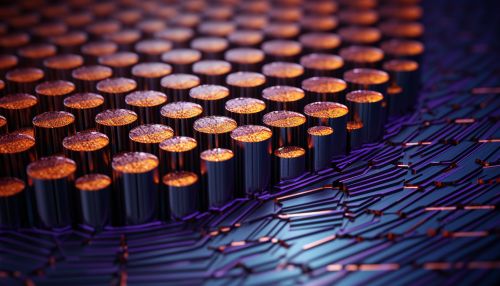Antiferromagnetism
Introduction
Antiferromagnetism is a phenomenon in condensed matter physics where the magnetic moments of atoms or ions in a material align in a regular pattern with neighboring spins pointing in opposite directions. This results in a net magnetic moment of zero, distinguishing antiferromagnetic materials from ferromagnetic and ferrimagnetic materials.


History and Discovery
The concept of antiferromagnetism was first proposed by French physicist Louis Néel in 1936, who later won the Nobel Prize in Physics in 1970 for his pioneering work in this field. Néel's work was instrumental in developing a theoretical framework for understanding antiferromagnetism, leading to significant advancements in the field of magnetism.
Fundamental Principles
Antiferromagnetism arises due to the quantum mechanical property of electrons known as spin. In an antiferromagnetic material, the spins of adjacent atoms or ions are aligned in such a way that they cancel each other out, resulting in a net magnetic moment of zero. This is in contrast to ferromagnetic materials, where all spins align in the same direction, and ferrimagnetic materials, where spins align in opposite directions but with different magnitudes.
Antiferromagnetic Materials
A variety of materials exhibit antiferromagnetic properties, including certain metals, alloys, and oxides. Examples of antiferromagnetic materials include manganese oxide (MnO), iron oxide (FeO), and certain rare-earth metal alloys. These materials are of significant interest in the field of material science due to their unique magnetic properties and potential applications in technology.
Antiferromagnetic Order
The arrangement of magnetic moments in an antiferromagnetic material is referred to as antiferromagnetic order. This order is determined by the crystal structure of the material and the interactions between the magnetic moments of the atoms or ions. The antiferromagnetic order can be disrupted by temperature, with the material becoming paramagnetic above a certain temperature known as the Néel temperature.
Antiferromagnetic Interactions
The interactions between the magnetic moments in an antiferromagnetic material are known as antiferromagnetic interactions. These interactions are mediated by the exchange interaction, a quantum mechanical effect that arises from the Pauli exclusion principle. The exchange interaction is responsible for the alignment of the magnetic moments in an antiferromagnetic material.
Applications
Antiferromagnetic materials have a variety of applications in technology. For example, they are used in the design of magnetic memory devices, such as random-access memory (RAM) and hard disk drives. They are also used in the development of spintronic devices, which utilize the spin of electrons to store and process information.
Future Directions
Research in the field of antiferromagnetism continues to be an active area of study, with scientists exploring new materials and applications. For example, researchers are investigating the use of antiferromagnetic materials in quantum computing and other advanced technologies. The field of antiferromagnetism promises to play a crucial role in the future of technology and our understanding of the physical world.
